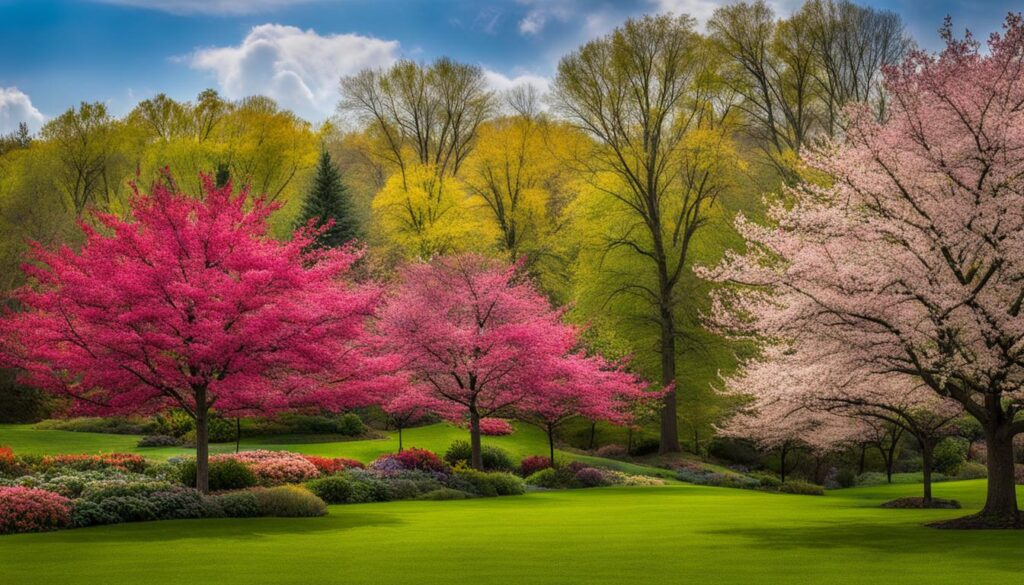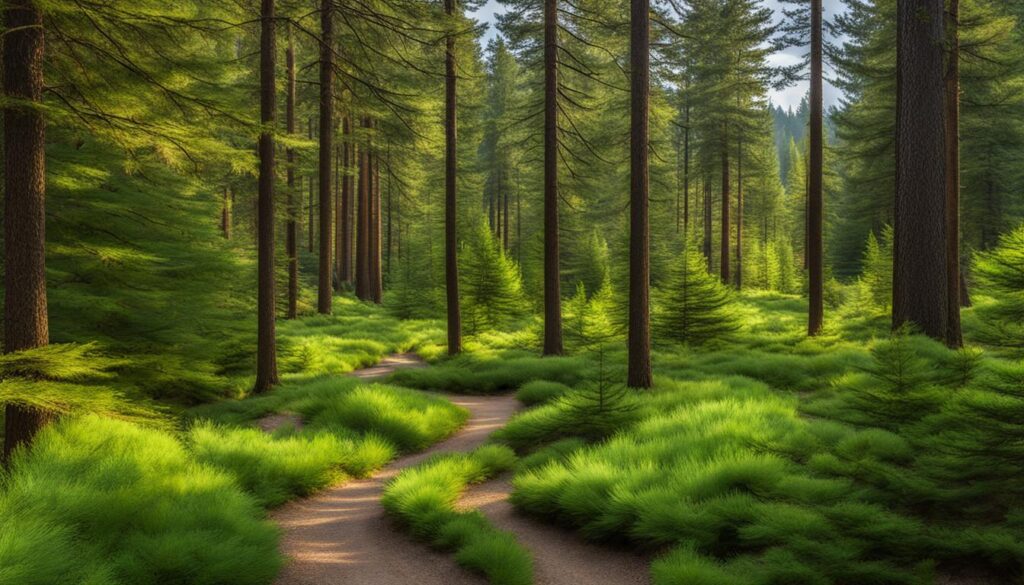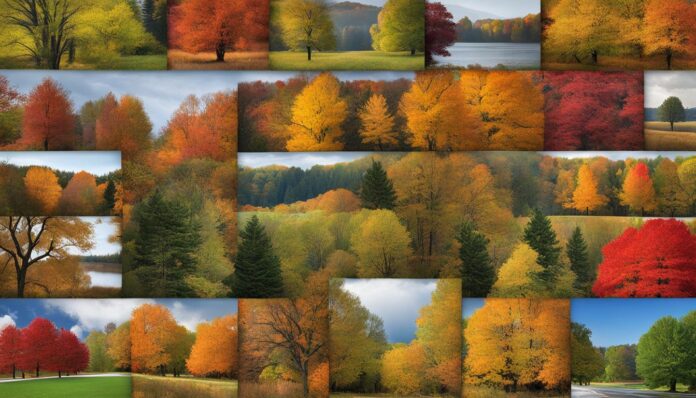As a resident of the Midwest, you understand the importance of selecting the right trees for your landscape. Whether you’re looking to buy, plant, or grow trees from Ohio to Nebraska, this complete tree guide is here to help. With recommendations for various tree types and valuable tips on tree selection and placement, you’ll be able to create a thriving and beautiful outdoor space in no time.
Key Takeaways:
- Consider the climate, soil conditions, and specific needs of your landscape when selecting trees for the Midwest.
- Deciduous trees like the Heritage River Birch and Dakota Pinnacle® Asian White Birch provide shade, structure, and colorful foliage.
- Flowering trees such as the Serviceberry and Northern Catalpa add beauty and color to your yard or garden.
- Shade trees like the Silver Queen Silver Maple and Hackberry are essential for providing relief from the hot sun.
- Choose Dutch elm disease-resistant elms for the Midwest, such as the Asiatic cultivars Accolade® and Triumph™.
Deciduous Trees for Midwest Landscapes
When it comes to crafting stunning Midwest landscapes, deciduous trees are a top choice. These trees not only provide much-needed shade but also offer a beautiful display of vibrant foliage throughout the seasons. Whether you’re looking to add structure, create colorful accents, or simply enhance the overall beauty of your landscape, there are several deciduous tree options that thrive in the Midwest region.
Recommended Deciduous Trees for the Midwest
A visually striking tree, the Heritage River Birch features unique exfoliating bark that adds texture and interest to your landscape. It is known for its adaptability to various soil types and its resistance to common pests and diseases, making it a durable and low-maintenance choice.
2. Dakota Pinnacle® Asian White Birch
The Dakota Pinnacle® Asian White Birch boasts a slim, upright form that fits perfectly into smaller landscapes or tight spaces. It is valued for its elegant appearance, with bright white bark that serves as a stunning focal point. This tree is also known for its resilience in harsh Midwest winters.
3. Shagbark Hickory
The Shagbark Hickory is a native Midwest tree that offers both beauty and functionality. Its attractive shaggy bark and golden fall foliage add visual interest, while its edible nuts provide a valuable food source for wildlife. This tree is not only a beautiful addition to your landscape but also contributes to the ecological balance of your surroundings.
Deciduous trees are a versatile and essential component of Midwest landscapes. Their ability to provide shade, structure, and a burst of color makes them a favorite among homeowners and landscape designers alike. With species like the Heritage River Birch, Dakota Pinnacle® Asian White Birch, and Shagbark Hickory, you can create a visually stunning and environmentally beneficial landscape that thrives throughout the seasons.
Flowering Trees for the Midwest
Flowering trees are a stunning addition to the Midwest landscape, adding bursts of vibrant colors and a touch of elegance. Here are three exceptional choices for flowering trees in the Midwest:
1. Serviceberry
The Serviceberry, also known as Amelanchier, is a versatile and beautiful flowering tree that thrives in the Midwest. With its delicate white spring flowers, it creates a picturesque scene that captures everyone’s attention. The Serviceberry also offers edible berries in the summer, attracting wildlife and adding to its allure. This tree adapts well to various soil types and can be an excellent focal point in any yard or garden.
2. Northern Catalpa
The Northern Catalpa, scientifically known as Catalpa speciosa, is a stunning tree that displays fragrant orchid-like flowers during the summer months. Its broad leaves provide ample shade, making it perfect for creating a comfortable outdoor space. The Northern Catalpa is a resilient tree that thrives in the Midwest’s climate and soil conditions, making it an ideal choice for landscapers and homeowners alike.
3. First Editions® Matador™ Maple
The First Editions® Matador™ Maple is a showstopper with its striking red fall foliage. This compact and sturdy tree showcases vibrant colors that illuminate the Midwest landscape during autumn. With its adaptability to various soil types and resistance to common pests and diseases, the Matador™ Maple is an excellent choice for adding visual interest and beauty to any yard or garden.

These flowering trees not only enhance the visual appeal of the Midwest but also contribute to the overall health and vitality of the ecosystem. By selecting these trees, you can create breathtaking landscapes that inspire awe and admiration.
| Flowering Tree | Main Features |
|---|---|
| Serviceberry | Delicate white spring flowers, edible berries, adaptable to various soil types |
| Northern Catalpa | Fragrant orchid-like flowers, broad leaves for shade, resilient to Midwest climate |
| First Editions® Matador™ Maple | Striking red fall foliage, adaptability to various soil types, resistance to pests and diseases |
Shade Trees for the Midwest
When it comes to creating comfortable outdoor spaces in the Midwest, shade trees are an essential addition. These trees not only provide relief from the hot sun but also add beauty and structure to your landscape. In this section, I will recommend three shade trees that are ideal for the Midwest region: Silver Queen Silver Maple, Hackberry, and Northern Acclaim® Thornless Honeylocust.
Silver Queen Silver Maple
The Silver Queen Silver Maple (Acer saccharinum ‘Silver Queen’) is a popular choice for shade in the Midwest. It features symmetrical form and dense foliage, making it an excellent shade tree option. The silver-gray bark adds visual interest to the landscape, while the large leaves provide ample shade. This fast-growing tree is adaptable to various soil types and can withstand harsh weather conditions, making it suitable for the Midwest. Plant the Silver Queen Silver Maple in an open area to allow it to reach its full potential.
Hackberry
The Hackberry tree (Celtis occidentalis) is a native Midwest shade tree that offers several benefits. It boasts an interesting bark with warty ridges and corky wings, adding texture to the landscape. The Hackberry’s leaves turn yellow in the fall, providing a stunning display of color. This tree can tolerate a wide range of soil conditions, including poor and compacted soils, making it a hardy choice for the Midwest. The Hackberry also attracts a variety of birds, making it a wildlife-friendly addition to your yard.
Northern Acclaim® Thornless Honeylocust
The Northern Acclaim® Thornless Honeylocust (Gleditsia triacanthos var. inermis ‘Northern Acclaim’) is another excellent shade tree option for the Midwest. As its name suggests, this variety is thornless, making it a safer choice around high-traffic areas. The Honeylocust has a finely textured canopy that provides filtered shade without completely blocking sunlight. Its delicate appearance complements a wide range of landscape styles. This tree is also tolerant of urban conditions, making it suitable for both rural and suburban areas in the Midwest.
| Tree | Features |
|---|---|
| Silver Queen Silver Maple | Symmetrical form and interesting bark |
| Hackberry | Unique bark texture and attractive fall foliage |
| Northern Acclaim® Thornless Honeylocust | Filtered shade and adaptable to urban conditions |
These shade trees offer a combination of beauty, functionality, and adaptability, making them ideal for creating comfortable outdoor spaces in the Midwest. Whether you’re looking for a fast-growing shade tree, a tree with unique bark, or a thornless option, there is a shade tree suitable for your specific needs. Consider the characteristics of each tree and choose the one that best complements your landscape vision.
Dutch Elm Disease-Resistant Elms for the Midwest
Dutch elm disease has been a significant issue for elms in the Midwest. However, there are varieties that show good resistance to the disease. Asiatic cultivars like Accolade® and Triumph™, along with ‘Prairie Expedition’ and ‘Discovery’, are suitable for Zone 3 and 4 with pretty good resistance. It is important to follow guidelines to minimize the spread of Dutch elm disease and ensure the health of your elms.
Recommended Dutch Elm Disease-Resistant Elms:
| Name | Description | Hardiness Zone | Resistance Level |
|---|---|---|---|
| Accolade® | Hybrid elm with a graceful vase-shaped form | 3-9 | Good |
| Triumph™ | Large elm with dark green foliage and a strong central leader | 3-9 | Good |
| ‘Prairie Expedition’ | Fast-growing elm with attractive glossy green leaves | 3-9 | Good |
| ‘Discovery’ | Compact elm with a rounded shape and excellent fall color | 3-9 | Good |
These Dutch elm disease-resistant elms offer beauty and resilience to the Midwest landscape. With their unique characteristics and resistance to the disease, they are an excellent choice for homeowners and arborists looking to combat Dutch elm disease while enjoying the beauty of elm trees.
Conifers for the Midwest
Conifers are an excellent choice for Midwest landscapes, as they provide year-round interest and structural elegance. These trees offer a variety of features that enhance the beauty of the region, including fragrant foliage, golden fall color, and large sticky cones. Here are three recommended conifers for the Midwest:
1. Concolor Fir
The Concolor Fir, also known as the White Fir, is a majestic conifer that adds elegance and charm to any landscape. Its silvery-blue foliage creates a striking contrast against the greenery of other trees, making it a standout choice. This tree also emits a pleasant citrus scent, adding a delightful aroma to the air. With its excellent adaptability to different soil types, the Concolor Fir is a reliable choice for Midwest gardens.
2. American Larch or Tamarack
The American Larch, also referred to as Tamarack, is a deciduous conifer that showcases brilliant golden fall color. This unique feature makes it stand out among other conifers in the region. The Tamarack is adaptable to a wide range of soil types and is known for its ability to thrive in wet areas. The beauty and vibrancy it adds to the landscape make it a popular choice for Midwest gardens.
3. White Pine
The White Pine is a classic conifer that offers timeless beauty and exceptional value to Midwest landscapes. Its soft, delicate needles create a serene and calming atmosphere. This conifer is known for its fast growth rate and tall stature, making it an ideal choice for creating screens and windbreaks. The White Pine’s adaptability to various soil types and its resistance to winter damage make it a reliable and stunning addition to any Midwest garden.
Here’s a visually engaging table summarizing the key features of these conifers:
| Conifer | Key Features |
|---|---|
| Concolor Fir | Fragrant foliage Golden fall color Large sticky cones |
| American Larch or Tamarack | Deciduous conifer Brilliant golden fall color Adaptable to wet areas |
| White Pine | Soft, delicate needles Tall stature Good for screens and windbreaks |
Take a moment to visualize the beauty of these conifers with the image below:

Choosing the Right Placement for Your Trees
Proper tree placement is crucial for the success of your Midwest landscape. When deciding where to plant your trees, it’s important to consider factors such as shade, wind direction, screening needs, and desired features. Taking these aspects into account will help ensure that your trees thrive and contribute to the beauty of your outdoor space.
Shade trees: Large shade trees are best placed in open areas where they can provide maximum shade coverage. Consider placing them strategically to provide relief from the hot sun and create comfortable outdoor spaces.
Evergreens: Evergreen trees are ideal for property lines and windbreaks. Use them to create privacy, buffer noise, and protect against harsh winds.
Ornamental trees: If you’re looking to add beauty and color to your landscape, ornamental trees are a great choice. Plant them in prominent locations to serve as focal points and enhance the overall aesthetic appeal of your yard.
When determining the placement of your trees, it’s also important to consider sun and wind patterns. Placing deciduous trees on the south side of your home can provide shade during the summer, reducing cooling costs. Meanwhile, planting evergreen trees on the north or northwest side of your property can act as a buffer against cold winter winds, increasing energy efficiency.
By carefully considering tree placement, you can create a harmonious and functional landscape that optimizes energy efficiency, provides shade, and enhances the beauty of your Midwest home.
Key considerations for tree placement:
- Shade requirements
- Wind direction
- Screening needs
- Desired features
- Sun and wind patterns for energy efficiency
Conclusion
Choosing the right trees for your Midwest landscape is essential for creating a thriving and beautiful outdoor space. When selecting trees, it is important to consider the specific needs of your region, such as climate and soil conditions, as well as the desired features of the trees. This complete tree guide for the Midwest provides recommendations for a variety of tree types, including deciduous, flowering, shade, and conifers, that are well-suited for the region.
By carefully selecting trees that are appropriate for the Midwest, you can ensure that your landscape will flourish and enhance the natural beauty of your home. Whether you’re looking to create shade, add color with flowering trees, or introduce evergreen conifers for year-round interest, this guide offers a comprehensive selection of trees to choose from.
Remember to also consider the right placement for your trees. Large shade trees are best placed in open areas to provide relief from the hot sun, while evergreens can be used to create property borders or windbreaks. Ornamental trees can be strategically placed to add beauty and color to your landscape. Taking into account factors such as shade, wind direction, and desired features can help optimize energy efficiency and create a comfortable outdoor environment.
With the complete tree guide for the Midwest and careful tree selection and placement, you can create a breathtaking landscape that thrives in your unique Midwest climate. Whether you’re a seasoned gardener or a novice, these recommendations will help you make thoughtful and informed choices for your Midwest landscape.
FAQ
What factors should I consider when selecting trees for the Midwest?
When selecting trees for the Midwest, it is important to consider factors such as climate, soil conditions, and the specific needs of your landscape.
What are some recommended deciduous trees for Midwest landscapes?
Some recommended deciduous trees for the Midwest include the Heritage River Birch, Dakota Pinnacle® Asian White Birch, and Shagbark Hickory.
What are some flowering trees suitable for the Midwest?
The Serviceberry, Northern Catalpa, and First Editions® Matador™ Maple are excellent choices for flowering trees in the Midwest.
What are some recommended shade trees for the Midwest?
The Silver Queen Silver Maple, Hackberry, and Northern Acclaim® Thornless Honeylocust are recommended shade trees for the Midwest.
Are there Dutch elm disease-resistant elms suitable for the Midwest?
Yes, there are varieties that show good resistance to Dutch elm disease in the Midwest. Some suitable cultivars include Accolade®, Triumph™, ‘Prairie Expedition’, and ‘Discovery’.
Which conifers are recommended for the Midwest?
The Concolor Fir, American Larch or Tamarack, and White Pine are recommended conifers for the Midwest.
How should I choose the right placement for my trees in the Midwest?
Consider factors such as shade, wind direction, screening needs, and desired features when deciding where to plant your trees.
What is the importance of choosing the right trees for my Midwest landscape?
Choosing the right trees for your Midwest landscape is essential for creating a thriving and beautiful outdoor space.

